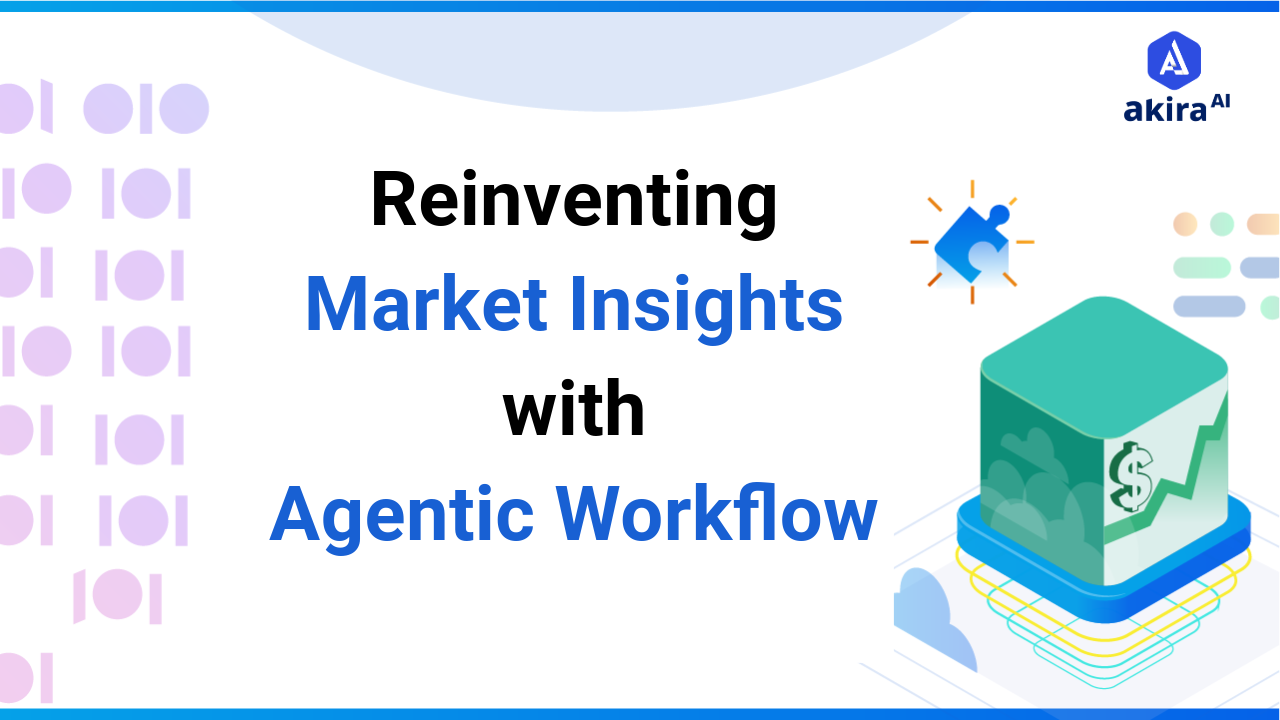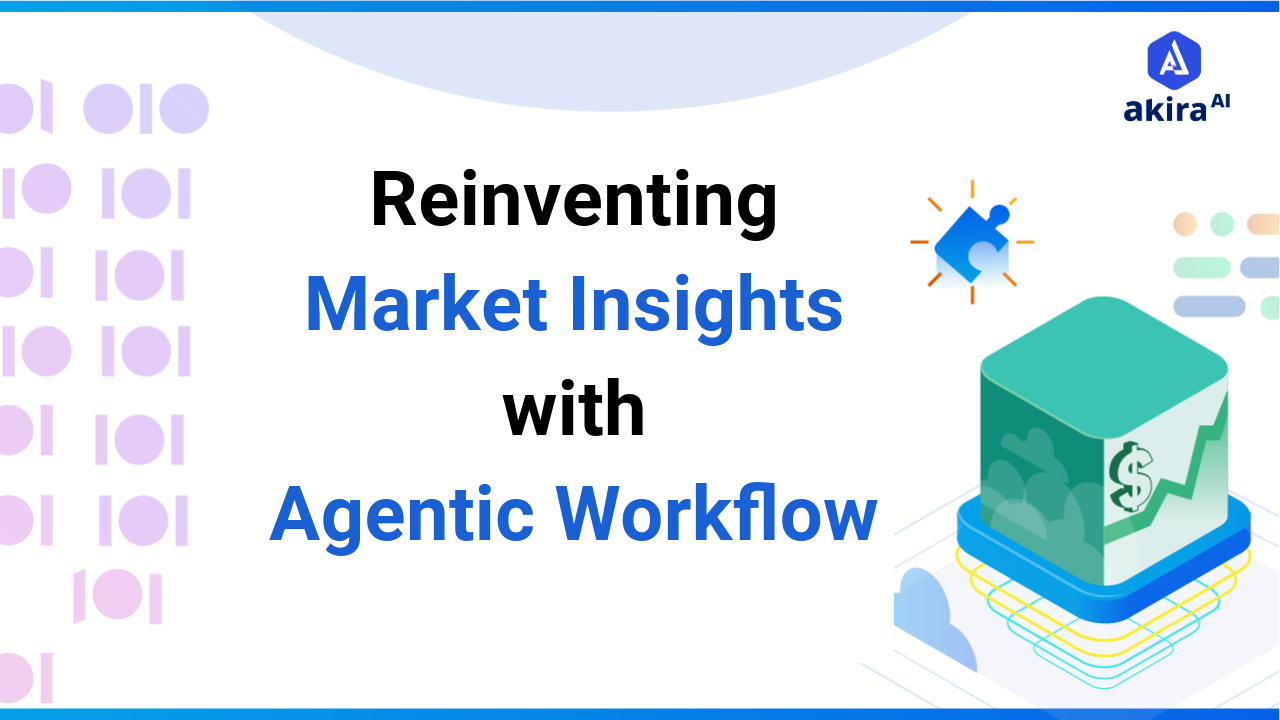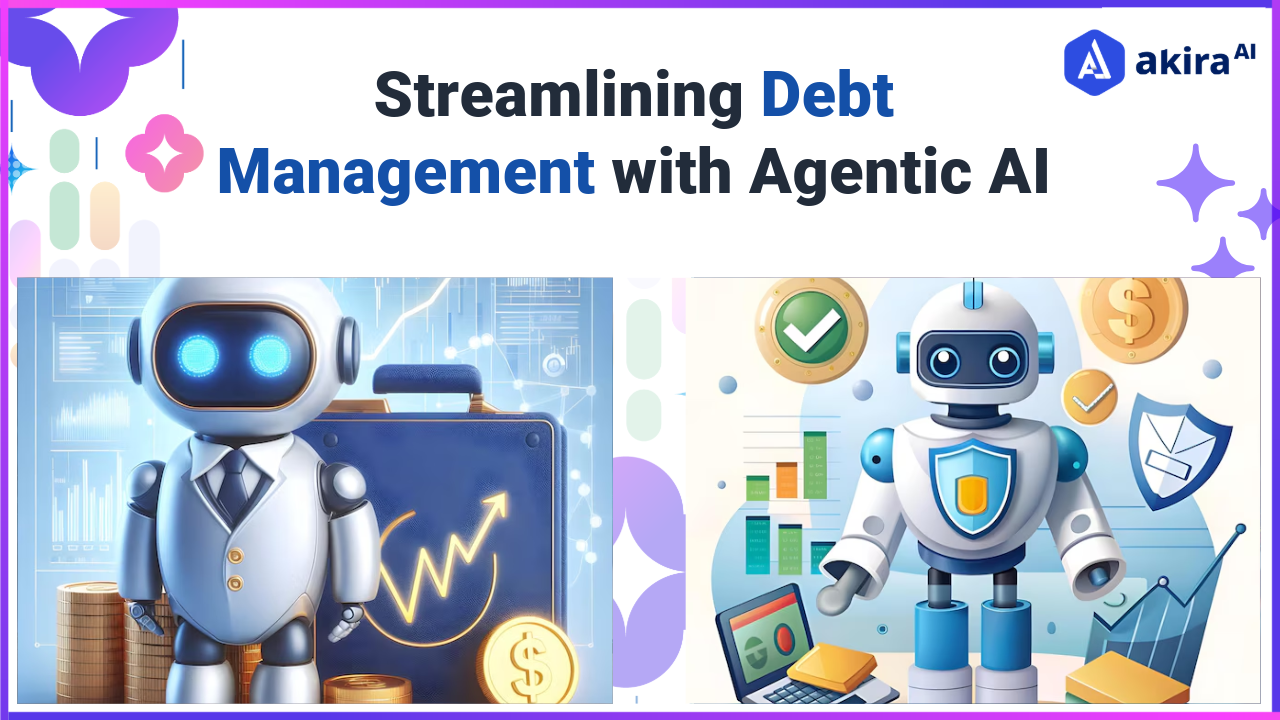Key Insights
AI agents, powered by agentic AI and agentic workflows, are transforming market trend analysis within the banking sector by providing real-time data processing, advanced predictive analytics, and improved risk management strategies. Unlike traditional methods, agentic AI-based analysis offers superior scalability, cost-efficiency, and precision, allowing financial institutions to respond swiftly to market changes. As these technologies continue to evolve, they are poised to enhance the sophistication of market analysis, driving more strategic outcomes and personalized banking services..

As the banking sector continues to evolve, it has become increasingly clear that technology is, more or less, a necessity. With the constantly increasing amount of data and market uncertainties, AI Agents have become a key to market signal discovery. These advanced systems can analyze vast datasets in real time, uncovering insights that would be nearly impossible for human analysts to achieve within the same time frame.
This blog explores, therefore, how these intelligent systems revolutionize how banks gain insights from data, make strategic business decisions, and deliver value to their customers in today's market.
What is Market Trend Analysis?
Market trend analysis is a form of market study that consciously tries to establish the pattern of previous performances to predict future market movements. This analysis is crucial for banks since it influences critical decisions regarding investment and risks, among other things. It examines several factors within a market, including prices and volumes and certain economic factors, to determine market outlooks. Gauging competition information can help banks predict profits and risks in high-velocity financial markets. Market trend assessment helps banks provide their clients with the right products and services. Also, a well-researched analysis can be done to address existing problems in institutions and reap benefits from opportunities that may arise in the future.
A Brief Overview of Market Trend Analysis in Banking
In the past, a majority of market trend identification in banking was a strongly manual or expert-based process. Financial analysts were employed to sort through massive amounts of information from economic and financial news volumes and offer analyses that helped in decision-making. However, with the large amount of data generated rapidly and the continuation of multifaceted financial markets, these methods are no longer sufficient.
Implementing the agents of artificial intelligence in the identification of market trends has, therefore, brought about a revolution. They are meant to acquire, process, and analyze the data independently, which helps make substantial gains in time to produce the result and accuracy of findings. These agents can gather data from various sources like balance sheets, articles, blogs, Facebook walls, and Twitter trends and have a complete profile of the market sentiment analysis.
By harnessing the power of data analysis and artificial intelligence, banking companies can get market experience in real-time and act faster and smarter. With the expansion of the banking sector, the role of these agents in market trend analysis is expected to expand, enabling institutions to remain competitive in an increasingly digital and data-driven environment.
Traditional Market Trend Analysis vs. Agentic AI-Based Market Trend Analysis
The transition from traditional market trend analysis to agentic AI-based analysis reveals significant efficiency, accuracy, and scalability differences. Understanding these differences is crucial for financial institutions to effectively integrate the agents into their processes.
|
Feature |
Traditional Market Trend Analysis |
Agentic AI-Based Market Trend Analysis |
|
Data Processing |
Manual data gathering and analysis |
Automated data collection and processing |
|
Speed |
Slower response times |
Real-time analysis and insights |
|
Accuracy |
Prone to human error |
Enhanced accuracy through machine learning |
|
Scalability |
Limited by human resources |
Highly scalable; can analyze vast data sets |
|
Predictive Capabilities |
Limited predictive modeling |
Advanced predictive analytics |
|
Cost Efficiency |
Higher operational costs |
Reduced costs through automation |
|
Adaptability |
Rigid and slow to adapt |
Quickly adapt to new data and trends |
How Do AI Agents Facilitate Market Trend Analysis?
The following advanced technologies and methodologies enable AI agents to analyze market trends.
-
Data Collection and Processing: These agents can continuously scrape and analyze data from multiple sources, including financial reports, news articles, and social media. This capability ensures that banks can access the most current and relevant data for practical analysis.
-
Real-Time Insights: The ability to process data in real-time provides analysts and decision-makers with timely insights. This immediacy allows banks to adjust their strategies quickly in response to changing market conditions, improving their agility.
-
Enhanced Predictive Analytics: Using machine learning algorithms with which these agents are equipped, such data may be assessed for patterns and trends that are hidden from the analyst. Such an improved ability provides a basis for banks to predict the movements of the market, thereby assisting them in investment or trading.
-
Risk Management: These agents can understand historical performance trends and the current market performance to identify risks relating to specific trends. That is why it is possible to suggest that a more subtle and accurate quantification of these risks will allow the banks to work on more suitable strategies for risk management.
-
Sentiment Analysis: These agents can provide the big picture of people's opinions by scanning through social media and news feeds regarding financial markets. Market sentiment analysis is beneficial as it helps traders and investors understand the context in which they operate when making decisions.
-
Automated Reporting: These agents can properly present reports encompassing key trends and insights by means of automation. This automation also creates efficiency and ensures that those making decisions are provided only with the necessary information at the appropriate time.
Use Cases of AI Agents in Market Trend Analysis
AI agents are employed across the banking sector to optimize market trend analysis. Some notable use cases include:
- Algorithmic Trading: Many banks utilize these agents for algorithmic trading, where market trend predictions drive automated trading decisions. These systems can react to market changes in real time, allowing banks to capitalize on opportunities faster than human traders.
- Sentiment Analysis for Trading Strategies: Artificial intelligence agents assess the responses of the market to major events or statements. These agents observe social media and other channels of communication and follow articles and feeds to deliver real-time data for trading.
- Risk Assessment and Management: In identifying and evaluating risk factors associated with market trends, these agents take on a very central role. They can assist the banks in coming up with proven ways of avoiding future risks by having an understanding of previous efforts and market environments.
- Portfolio Management: Some banks use these agents to increase the possibility of achieving the optimum management of portfolios. In terms of trends and proposals determining the best possible areas of investment, it helps banks to enhance the investment possibilities.
- Customer Insights and Personalization: The customer data is used by the AI-based systems to come up with information on trends, particularly in customer spending patterns. Such information can be utilized to develop and plan the banking products and services that will help improve the quality of services, hence increasing customer loyalty.
Akira AI Optimizes Market Trend Analysis
 Fig 1: Process Flow of Market Trend Analysis
Fig 1: Process Flow of Market Trend Analysis
Akira AI's agentic AI platform is specifically designed to enhance financial operations, including market trend analysis. The platform leverages a combination of AI agents to optimize various processes involved in trend analysis.
- Data Aggregator Agent: Gathers and stores data over time from various sources within the company and external environment to ensure that the contents of the analysis are timely. This agent pulls data from multiple platforms so that information about them is gathered and ready for analysis.
- Predictive Analytics Agent: Incorporates artificial neural networks to study previous sales data and their trends in the future marketplace. This agent allows banks to predict future trends in the market for consumption, which, in turn, promotes better planning.
- Sentiment Analysis Agent: Uses NLP to qualify the stance of news pieces and social media posts about the financial markets. This agent seems to give a first-hand opportunity to monitor trends in people's perception that would likely affect the market.
- Reporting Agent: Automates the generation of financial reports, presenting the analysis findings in a clear and actionable format. Streamlined reporting enhances communication across teams and improves decision-making efficiency.
- Risk Assessment Agent: Assesses the risks banks may likely face as they adapt to these trends by providing the necessary information through the evaluation so that acceptable measures can be taken. This agent provides a degree of measurement of risks and, therefore, improves risk management strategies.
Operational Benefits of AI Agents in Market Trend Analysis
 Fig 2: Key Features of Agentic AI In Market Trend Analysis
Fig 2: Key Features of Agentic AI In Market Trend Analysis
The usefulness of AI agents presupposes several benefits for the operation of the business. Here are the major ones:
-
Improved Accuracy: Advanced analysis of trends increases their accuracy due to the application of machine learning. This means that by avoiding errors made by human beings, the banks will be able to get better forecasts and investment plans.
-
Scalability: These agents enable workers to handle immense amounts of data with the same proportions of workforce and time. This scalability allows banks to consider vast data and provide better solutions to changing market situations.
-
Enhanced Agility: Such predispositions make it possible for banks to respond to changes in the market faster, courtesy of information that these agents feed in real-time. This agility is essential in the current volatile financial environment of financial sector competition.
-
Comprehensive Insights: This AI-based solution offers the prospect of a view that unifies market data across multiple sources of information. Comprehensive screenings improve the quality of all the solutions provided and the decisions adopted.
-
Cost Efficiency: Cost savings in relation to manual efforts can be a big plus for banks as they look for ways to increase their profits. Due to participation in managing processes and controlling resources and flows, these agents enhance the cost-effectiveness of an organization.
-
Better Risk Management: These agents enhance the identification and assessment of risk involved with market trends. They can also help banks develop better risk control measures and shield their investments from more dangers.
Technologies Reshaping Multi-Agent for Advanced Document Processing
- Machine Learning Algorithms: Market research and pattern recognition are done using large datasets analyzed by machine learning algorithms. They get better as the program is used over a certain time, as the database builds up, and banks will be able to make correct and proper decisions.
- Predictive Analytics: Market analysis and risk estimating tools rely on statistical analysis and artificial intelligence for future trend forecasting. Operating with the help of customer behavior and econometric models, these tools allow banks to introduce efficient strategies.
- Natural Language Processing (NLP): NLP assists the artificial intelligence agent in structuring the data acquisition from structured objects like articles and social media. This lets banks know the sentiments of the people and come up with the right decisions depending on the current prevailing market forces.
- Big Data Analytics: Big data analytics allows AI agents to process vast volumes of both structured and unstructured data. This holistic view of market conditions enables banks to respond quickly to changes and seize opportunities.
- Real-Time Data Processing: AI agents equipped with real-time data processing capabilities can analyze market data as it occurs. This immediacy enhances trading strategies and risk management, allowing banks to react swiftly to market fluctuations.
- Blockchain Technology: Blockchain provides secure and transparent records, improving the reliability of data for market analysis. Its use in transactions ensures data integrity, leading to more accurate predictions.
- Cloud Computing: Cloud computing offers scalable storage and processing power, essential for analyzing large datasets. This technology enables banks to access resources efficiently and adapt to the growing volume of market data.
Future Trends of AI Agents in Market Trend Analysis
The future of AI agents in market trend analysis holds excellent promise as technology continues to evolve. Several trends are expected to shape the future landscape:
-
Increased Integration of Machine Learning: When algorithms for machine learning are well-developed, artificial intelligence agents are capable of processing more extensive volumes of information and answering more complicated questions. This advancement will enable the development of predictive attributes and lead to better predictions of market trends.
-
Real-Time Data Analytics: Real-time data analytics will enable banks to act on market changes as they happen, hence benefiting from this integration. This immediacy will also enhance both the speed in making decisions and flexibility in responding to the changing market environment to seize new opportunities.
-
Enhanced Natural Language Processing: Enhancing AI solutions with higher natural language processing capabilities will permit the systems to analyze and compile market moods. It will increase the efficiency of sentiment analysis and improve the knowledge of trading in the stock market.
-
Compliance Monitoring: These agents will become vital in compliance monitoring as the regulatory environments around organizations continue to become complex. These agents will help banks navigate legal requirements while optimizing their operations.
-
Advanced Risk Management Tools: Risk management will see more employment rates with agents that are capable of replicating market situations and risks. Thus, the stated capability will be useful in strengthening the evaluation of risks and general financial position.
-
Greater Focus on Ethical AI: With AI penetration in the financial sector, the topic of ethical AI practices will become more poignant. For the industries to sustain consumer confidence, transparency, accountability, and fairness in the decisions made by the AI systems will become critical for uptake.
- Expansion into Non-Traditional Data Sources: AI-based solutions will increasingly analyze non-traditional data sources, such as satellite imagery or web traffic, providing a broader understanding of market dynamics. This integration can reveal insights that standard financial metrics may overlook.
Conclusion: AI Agents for Market Trend Analysis
Integration of AI agents in market trends can be understood as a model involving all the improvements that the banking industry has reached in terms of efficiency and accuracy of results. These technologies will continue to grow and evolve over time and will introduce improved analytical sophistication in the functioning of banks as well as more sophisticated products. Assuming this future is necessary for banks wanting to navigate the world of leadership in finance, the development of these agents in banking is still in its infancy stage, and this is the best chance for many more innovations to flourish.


